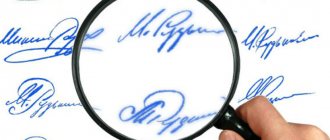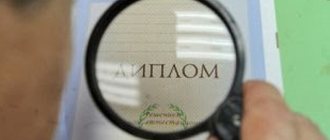If you hold a high position or your job involves some kind of resources (such as money), there is a high chance that you will be tempted to use your position for personal gain. As a rule, to obtain benefits, you have to draw up documents containing false information or make changes to existing ones. Of course, you can convince yourself that there is nothing criminal in your actions, but the law does not think so. Such “initiatives” have a very specific name - official forgery (SP).
If you are accused of official forgery, we recommend enlisting the support of a professional lawyer. The specialist will protect your rights and do everything possible to mitigate the punishment.
Official forgery: general characteristics
So, what does the law mean by the phrase “official forgery”? SP is the introduction of false information into documents or, on the contrary, erasing documentation, as well as changing the content of documents (reliable information is replaced by unreliable information) or drawing up initially false documents. In practice, official forgery can be expressed as:
- changes in the date of issue of the document;
- signature forgery;
- etching part of the text;
- forgery of seals, etc.
A distinctive feature of official forgery is the presence of direct intent, i.e. the culprit must deliberately introduce information into the document that distorts its actual content, make erasures, etc. If false information appeared in a document as a result of negligence, then such actions are not official forgery, but negligence.
Important! Often, official forgery accompanies the commission of other crimes. For example, the culprit may include false information in documents in order to hide the embezzlement.
How do they prove the fact of official forgery?
In order to prove official forgery (the fact of making changes to a document or the presence of corrections), at the moment there are no problems. Modern methods of forensic examination allow specialists to detect counterfeiting of a seal, stamp or letterhead, etching of signs, etc., made in almost any way.
It is also not difficult to carry out a handwriting examination, and it will not be difficult to find out who exactly signed a certain document. It is also quite possible to detect the fact of making changes to electronic versions of documents: experts use innovative techniques in their work.
The signature on the power of attorney was forged
The court decided that the bank was not to blame, since it verified the authenticity of the power of attorney. It was a real power of attorney, executed by a valid notary. Which Malykhin did not reveal. During the trial, it was confirmed that the signature on the power of attorney was forged. The information in the passport that the fraudster brought to draw up the power of attorney was correct. But the photograph in that passport, as the notary was convinced during the trial, was not Malykhin.
The Alfa-Bank client plans to go all the way - if necessary, right up to the Strasbourg court, he told Banki.ru. He believes that “the theft of funds from the account could have been organized by the bank itself,” and points to inconsistencies in the case. Including, according to Malykhin, the bank deleted the correspondence about the first incident with the power of attorney from the chat and unilaterally changed his residential address to St. Petersburg.
“The only explanation for the change of address is: “It has nothing to do with this dispute,” he writes.
The press service of the credit organization Banki.ru responded that the bank fully complies with the law and checks all powers of attorney in several ways, including reconciliation with the register of powers of attorney of the Federal Notary Chamber.
“In the described case, the power of attorney was genuine and valid, which the court recognized. The main thing that can be recommended to clients is to take care of their personal data and not transfer it to third parties unless necessary,” concluded Alfa-Bank.
Punishment for official forgery
The main thing you need to know about official forgery is that such actions are a crime, i.e. responsibility for them is provided for by the Criminal Code of the Russian Federation (CC RF). Article 292 of the Criminal Code of the Russian Federation contains two parts - the first is devoted to “simple” official forgery, the second - to a similar act, but entailing a significant violation of rights and legitimate interests (regardless of whose rights were violated - a person or a group of people, a legal entity, protected legislation interests of the state or society).
Punishment for joint ventures can vary from a fine to imprisonment. What responsibility a person who commits official forgery will bear depends on the part of Art. 292 of the Criminal Code of the Russian Federation, according to which he will be found guilty, as well as from some other circumstances. In particular, the criminal law provides for the following types of punishment for joint ventures:
- fine (up to 500 thousand rubles or in the amount of the perpetrator’s income for a period of up to 3 years);
- compulsory work (up to 480 hours);
- correctional labor (up to 2 years);
- forced labor (up to 4 years);
- arrest (up to 6 months);
- imprisonment (up to 4 years).
If the punishment is imposed under Part 2 of Art. 292 of the Criminal Code of the Russian Federation, then additionally, by a court decision, the perpetrator may be prohibited from engaging in certain activities for a period of up to 3 years. It may also be decided to prohibit the offender from holding certain positions during the same period.
Important! According to Art. 292 of the Criminal Code of the Russian Federation, punishment is imposed on officials, state and municipal employees. An ordinary citizen cannot be held accountable for official forgery.
The person with the power of attorney wanted to withdraw all the money from the account
The account from which the money disappeared was opened in 2015 in a branch of Alfa-Bank in Moscow. On April 17, 2021, Malykhin, according to him, received a call, introduced himself as the security service of Alfa-Bank in St. Petersburg and asked whether he had issued a notarized power of attorney issued in the name of A. Yu. Timofeev. The person with the power of attorney wanted to withdraw all the money from the account.
“I said not to issue it and to take action, since the one who brought the power of attorney is a fraudster and I did not issue the power of attorney,” writes an Alfa-Bank client.
A month later, a new power of attorney was brought to the St. Petersburg branch of Alfa-Bank - this time for citizen I.B. Nazarov. According to it, all the money from Roman Malykhin’s account was written off.
The Alfa-Bank client almost immediately contacted the St. Petersburg police with a statement of fraud, but the initiation of a case was refused due to the “absence of a crime.” In July 2021, Malykhin filed a claim with the Prikubansky District Court of Krasnodar against Alfa-Bank under the Law “On the Protection of Consumer Rights” for compensation for material damage, penalties, fines, moral damages and legal expenses. In May, the court rejected the claim, and the appeal decision was the same on September 8, 2020.
What else do you need to know about official forgery?
Several years ago, the Supreme Court of the Russian Federation expanded the understanding of official forgery. Previously, punishment was imposed, as a rule, for actions with documents created on paper. But since electronic document management is now developing in most areas, the joint venture may also concern electronic versions of official documents.
In addition, it must be taken into account that the perpetrator is held accountable even when the official forgery he committed did not entail any consequences. Those. if, for example, you corrected the date in a document, but did not have time to take advantage of it (get a benefit for yourself), the punishment will still be imposed if this fact is revealed.
Thus, official forgery is a crime for which the perpetrator is held criminally liable. If for any reason they want to impose a punishment on you under Art. 292 of the Criminal Code of the Russian Federation, contact a lawyer for help. The specialist will prepare the necessary documents and ensure representation of your interests.
Source:
Official forgery
Types of fakes
In the modern world, there are two types of signature forgery - manual and technical. Let's look at these issues in more detail, as there are a lot of subtleties.
Manual signature falsification
Due to the development of technology, it is becoming easier for modern criminals to commit crimes every day. Manual signatures are especially often forged, since the process does not require the use of specialized equipment. The manual method of forging a signature includes three types of falsification:
- The first method is the simplest and therefore known to everyone. This is a forgery of a handwritten signature. This requires some talent, because... This method involves restoring from memory or using the original manually. Almost everyone during their school days tried to forge teachers' signatures in their diaries. There are people who have developed this talent and use it illegally. It is usually easy to detect such fraud. As a last resort, an examination of the handwriting is carried out. The analysis requires an experienced professional, an original (usually 10 examples) and paper to be checked. In this case, documents where the signature was affixed with too much time difference are not subject to verification, because with age a person’s handwriting changes and it is more difficult to establish identity.
- The next method is one in which additional improvised means are used during counterfeiting. One of these tools is carbon paper, which is freely available in almost every office supply store. It is believed that such means allow one to achieve better quality during the falsification process.
- The third method involves the use of computer programs and a conventional laser printer. Scanned signatures are restored using a printer on paper. This type of counterfeit is more advanced and requires examination using modern equipment to identify the forgery.
Technical forgery of signature
Technical forgery of a signature is considered to be those methods of falsification that use computer technology, special equipment, or simply improvised means. The difference between a technical forgery and a manual one is that the forgery is not produced by handwriting, but by copying the signature from the original. The most commonly used types of technical counterfeiting are:
- Redrawing the signature in pencil and then tracing the strokes with ink. Typically, a soft pencil is used in this case. It is thanks to him that falsification is detected - coloring pigments remain on the paper.
- Imitation of a signature using special paper, exposed to light or by pressing, followed by tracing the contours with ink.
- A method of forging a signature using substances that have copying properties. In this case, various emulsions, films, photographic paper and even egg white can be used.
- Forgery using an electrographic apparatus. Today this is the most popular way to forge a signature. It is distinguished by the shine of the ink, the absence of relief and flaking of the dye.
- A less popular, but used method is falsification using printers. As a rule, in this case an inkjet or laser printer is used. Dot matrix printers are least suitable for these purposes. This type of forgery is also distinguished by its lack of relief; in addition, tiny drops of toner can be distinguished. It is easy to distinguish such a fake from the original - if water gets in, the outline of the signature will blur.
- Forgery using a printed form - facsimile. This method is the most difficult to determine, because... in this case, the fake will be most similar to the original. A distinctive feature will be the absence of grooves left by writing instruments.
Signs of forgery of a signature or parts of a document
In order to register the fact of signature forgery, it is necessary to identify the signs. They will differ for different methods of producing a forged document, but there are basic, common characteristics:
- The presence of paired lines, the sharpness of rounded strokes, traces of preparation. Such signs indicate that the signature was copied from the original.
- The presence of unnatural thickenings, blunt ends of lines, excessive tortuosity. These characteristics characterize the copying method of counterfeiting using glass.
- If you copy using special paper, the document will show pigment marks and poor line alignment. This sign is easy to detect - all you need is a magnifying glass and good lighting, or an infrared lamp.
- When falsifying a signature using materials with increased copying ability, emulsion particles can be found on the paper. There will also be no relief. Upon closer examination, you can see that the tinting of the signature is uneven, and small splashes of paint will be found next to the signature.
Features of bringing to responsibility
In order to bring the perpetrators to justice, it is necessary to have a falsified document and a professional expert’s opinion confirming the fact of forgery. It is necessary to have papers with a fictitious signature on hand, because they will serve as physical evidence. However, criminal prosecution for signature forgery has a number of features:
- Nowadays, no one will be surprised by forging the director’s signature at work. There are emergency moments in which the person committing this act does not have selfish goals. But in order to avoid punishment for forging a signature, it is still better to obtain written permission from management. If there is none, then an overly proactive employee may be fired for exceeding his authority.
- The situation is different - the employer falsifies the employee’s signature. Forging a signature on a payroll slip is the most common example. Thanks to such forgery, the entrepreneur may not pay the employee wages. If this fact is discovered, you must immediately file a claim in court.
- Forgery of signatures in sales contracts is also common today. If falsification is detected, such a document loses its validity, and the fraudster will be held responsible for forging the signature.
- Forging a signature in the minutes of a general meeting today also involves punishment, because For some time now, this document has been considered official. In this case, the most difficult thing will be to find the culprit of the forgery.
- Article 327 also provides for punishment for forging signatures on documents. The punishment in this case is determined by the court and depends on the severity of the crime.
- Forging a signature on the acceptance certificate may result in the contractor not receiving money for the work performed. In this case, a common mistake could have occurred - some employee signed the act for management. In any case, only examination and trial can help here.
- For violators, forging a signature in court may turn out to be a more serious crime than expected. The fact is that in this case Art. 303 also comes into force. The Criminal Code of the Russian Federation, which considers facts of falsification of evidence and the results of operational investigative activities.





